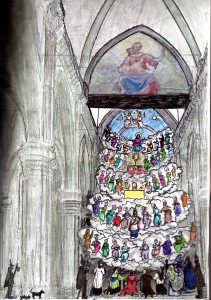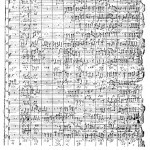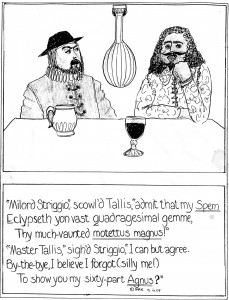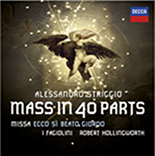Phil Dale and Adrian France
Further historical notes
Genesis of the Striggio 40-part works
No record exists of the origins of either Striggio’s 40-part mass or his surviving motet in 40 parts, Ecce beatam lucem. This latter work is probably the second such motet that Striggio composed and is first clearly mentioned at the Wittelsbach wedding in Munich in 1568 (more on this in the CD sleeve).
Striggio’s first 40-part work – lost, text unknown, and until now thought to have been Ecce beatam – is known to have welcomed papal envoys to Florence in July 1561. No title is given. The next month, Striggio sent a work for 40 parts to his native Mantua in honour of a recent Gonzaga marriage and his letter to the Duke partially implies that the two pieces are the same. Similarly no title is given and no further record of the piece has been found.
The most likely scenario for the inception of the motet and mass on this recording (the mass uses and develops material from the motet) is that both were commissioned for a 1565 Florentine dynastic marriage of enormous importance to the Medici, between the Prince Francesco (later Grand Duke Francesco I, but then regent, with his father Cosimo I retaining most of the executive power), and Archduchess Johanna of Austria, daughter of the recently-deceased Emperor Ferdinand I. By a calculated piece of symbolism, the music was by the leading Florentine composer, its text from a neo-Latin ode by Paul Melissus (né Schede), a young German poet then resident in Vienna (the bride’s home town), and whom her father had the previous year declared Poet Laureate. (Melissus was a cradle Lutheran, and may already have had leanings towards the Calvinism that he later espoused: but both Ferdinand and his successor Maximilian II were nominal Catholics sympathetic to the Protestant cause.)
 The wedding festivities were on the most lavish scale, and the mass setting will have graced the extravagantly-staged nuptial mass in the duomo, Striggio’s five choirs presumably ranged around the quire beneath Brunelleschi’s great dome and conceivably on a cloud machine and attired as Angels. (Hugh Keyte has sketched what this might have looked like – see right.) The motet will have featured a few days earlier in the course of the bride’s formal entry into the city, at her ecclesiastical reception in the duomo nave. The printed account of a comparable reception of a Medici bride recounts how singers and instrumentalists, masked and costumed, descended on cloud machines from the vault of the easternmost bay to present a spectacular scena sacra. Assuming that Ecce beatam was similarly mounted in 1565, the sacred scene will have embodied the vision of the New Jerusalem of Melissus’s ode, which is entitled ‘Enthusiasticon’: at the summit, the Holy Trinity enthroned against the cosmos; around and below, Christian saints and Old Testament patriarchs and prophets, with a singing and harping King David given pride of place.
The wedding festivities were on the most lavish scale, and the mass setting will have graced the extravagantly-staged nuptial mass in the duomo, Striggio’s five choirs presumably ranged around the quire beneath Brunelleschi’s great dome and conceivably on a cloud machine and attired as Angels. (Hugh Keyte has sketched what this might have looked like – see right.) The motet will have featured a few days earlier in the course of the bride’s formal entry into the city, at her ecclesiastical reception in the duomo nave. The printed account of a comparable reception of a Medici bride recounts how singers and instrumentalists, masked and costumed, descended on cloud machines from the vault of the easternmost bay to present a spectacular scena sacra. Assuming that Ecce beatam was similarly mounted in 1565, the sacred scene will have embodied the vision of the New Jerusalem of Melissus’s ode, which is entitled ‘Enthusiasticon’: at the summit, the Holy Trinity enthroned against the cosmos; around and below, Christian saints and Old Testament patriarchs and prophets, with a singing and harping King David given pride of place.
Mysteriously, Ecce beatam comprises only part of Melissus’s ode. In the unset initial Strophe the Holy Spirit infuses the poet with divine rapture and Christ leads him to view the celestial vision. It is possible that Striggio did set this section. He was celebrated for his unique performances of small-scale works, singing the leading part while simultaneously playing the entire texture of up to four parts on a lirone, a kind of multistringed bass viol with flat bridge (to be heard clearly on the recording in the Galilei track, with two lutes). If Striggio did indeed set Melissus’s Strophe and performed it thus, there would have been a splendid coup de théatre when, towards the close, the sky shutters above him were withdrawn and the massed cloud-borne forces of Ecce beatam began to descend.
Hugh Keyte with RH
The instrumentation of Renaissance sacred vocal music
‘Vocal’ would in many cases be a mis-nomer, since the convention of underlaying all parts with text did not necessarily imply that all were to be sung. A composer, as he worked, might not yet know which parts would eventually be sung and which played, since composition and instrumentation would often be two distinct processes, not necessarily carried out by the same person. For instrumentalists, universal texting acted as a guide to stress and articulation. For composers it was a useful discipline, freeing them from the temptation to freewheel when devising ‘fill-in’ parts, and so ensuring the kind of unified musical texture that was an ideal of the period. When Lassus directed Striggio’s Ecce beatam at Munich in 1568 there will have been no hint of instrumental participation in the performing material, but he automatically assigned some parts to voices, some to instruments. His eccentric scoring must have been light years from Striggio’s (unknown) original one, but the fact that Striggio was almost certainly present and made no objection illustrates the amount of freedom that was allowed. All this applies to Spem in alium as much as to Striggio’s motet and mass, for Tallis’s motet was a deliberate and highly successful fusion of English and (loosely) North Italian techniques, some (not all) of the latter imitated from Striggio. Many of Spem‘s Italianate features are precisely the kind that would have suggested instrumental participation, and we can scarcely doubt that both voices and instruments were involved in that first performance at Arundel House in (sometime before 1572).
Hugh Keyte
Tallis and dissonance
 A harmonic feature of Tallis’s church music is the presence of the dissonance caused by the major and minor versions of a particular chord sounding at the same time (or very close to each other). The way Tallis lays these out generally involves the minor 3rd at the top of the texture and the major third below. Such a layout fits the natural presentation of these intervals to be heard in the harmonic series, which explains why such dissonant moments actually sound pleasurable and not particularly dissonant – though theoretically ‘incorrect’. (Flemish composer Nicolas Gombert’s music often inverts this with the major third above and the minor third below, which creates a quite different effect. To hear a very short clip of this being dissected, click here and play the ‘Tallis in Wonderland’ film from about 2’55” for just 30 seconds.)
A harmonic feature of Tallis’s church music is the presence of the dissonance caused by the major and minor versions of a particular chord sounding at the same time (or very close to each other). The way Tallis lays these out generally involves the minor 3rd at the top of the texture and the major third below. Such a layout fits the natural presentation of these intervals to be heard in the harmonic series, which explains why such dissonant moments actually sound pleasurable and not particularly dissonant – though theoretically ‘incorrect’. (Flemish composer Nicolas Gombert’s music often inverts this with the major third above and the minor third below, which creates a quite different effect. To hear a very short clip of this being dissected, click here and play the ‘Tallis in Wonderland’ film from about 2’55” for just 30 seconds.)
One particular layout of this dissonance is known as the ‘English cadence’, though the effect is as often found in continental polyphony of the first half of the 16th century.
The English Cadence However, in both English and continental composers, the realisation of this effect usually depends on the editorial addition of sharps and flats, according to the shape of the melodic phrase and its place in the harmony. The problem is that the contemporary custom for this, while described in some theory books, doesn’t mean that it was done the same in every town in every country. Local custom and preference must surely existed. This continues today: Peter Phillips’ recordings with The Tallis Scholars of much Netherlands Renaissance polyphony tend to eschew this colour while Bo Holten’s encourage it.
The fact that such dissonances do clearly exist in Tallis’s music doesn’t necessarily imply that they should happen in every single place where they could happen. Spem has been a particular casualty of this in recent years with every potential dissonant moment usually made dissonant. Part of the reason for this is that existing editions are mostly based on the first Latin version of the work (the Royal Appendix ms) which contains more sharpened Cs (that create the dissonance) but only dates from the 18th century. Hugh Keyte’s new edition for this recording is based on the earliest existing score of the music but underlaid in English (‘Sing and glorify’) and known as the Egerton manuscript which dates from only about 20 years after Tallis’s death. This earlier version of the score has many fewer dissonant moments.
Of course, one can editorially add accidentals (sharps or flats) but the wholesale of milking of every opportunity for a false relation (the technical term for a dissonance) is self-indulgent. For this recording, Hugh Keyte and I went through every instance where the intention was not clear and subjected it to various criteria. At the end we still disagreed in places, of course, but there were considerably fewer C sharps as a result and it was more scientific than the usual painting of the piece as dissonant as possible for the pure weirdness value (although no-one likes a false relation more than me, except possibly my wife, and some of her friends.)
Another aspect to the dissonance is described by Hugh Keyte in his sleeve note on this piece. “Tallis shows off his mastery by driving chains of fugal entries through the entire ensemble: and to do so with so many parts he is virtually forced to forge a harmonic idiom that embraces unprecedented types and degrees of dissonance.” The dissonance he is referring to here is not the major/minor clashes, but caused by Tallis’s avoidance of any two parts moving in the same direction by the interval of a fifth or an octave (considered very clumsy in music theory and still frowned upon in harmonic technique lessons today). This is one thing when writing in five or six parts but an almost impossible task when writing for forty. Tallis’s solution is to delay the resolution of a vocal line (or conversely to push it forward), leading to ‘passing notes’ that are not part of the main intended chord and which create extra notes in any intended chord. Striggio didn’t face these problems to the same extent because his writing is less truly polyphonic (with interdependent melodic parts) and more chordal, although you can hear one such of his played lowish in a recorder in Agnus II at 0’36-7.
In case that has left you none the wiser, a specific case is the passage in Tallis’s Spem: ‘creator caeli et terrae’ (sound clip below) From b.96 a two-chord sequence is set up: D minor / A minor repeated several times. The C naturals which case the A chord to be minor and not major are here incontrovertible because of their melodic shapes. That pattern is clearly set up and established before any phrases that might allow C sharps (under other circumstances)Â are introduced. The first potential C sharps then appear on the last note of b.98 and in b.99 but changing them would here imply that the established harmonic pattern was changing, when the whole point is that it is being repeated. This is backed up by the Egerton manuscript which includes not a single sharp in this passage. The two-chord pattern (in different transpositions) dominates the next section, including two more bars of D and A minor that we believe should not be editorially amended to include the C sharps that most recordings include.
The pay-off for this editorial harmonic restraint is the magnificent full choir chord (all 40 voices) on ‘Respice’ on the (until now) suppressed A major with its rich C sharp. Withheld from the previous section, its impact here is much stronger. Have a listen (if anyone’s still reading). Â Â RH
From Spem in Alium
Numerology in Spem
“I love the girl whose number is 545.” Grafito on a wall in Pompei.
This Ancient Roman grafitist was clearly confident that the girl in question would know her number, just as her modern counterpart might know her star sign. In the 16th century there was constant use of number symbolism (using the 24-letter Roman alphabet) by writers and artists, though how common it was in educated circles is unclear.
The 40 voices of Striggio’s two pieces and Tallis’s Spem may hide many secrets. 40, though, had many meanings. In the Bible, 40 simply meant ‘a lot’. Christ remained in the wilderness for 40 days (thus the length of Lent). Moses’ stay on Sinai lasted 40 days as did the rains that produced Noah’s flood. The Jews were in the desert for 40 years.
Is this one reason that Striggio chose this number for his first large-scale work, Ecce beatam lucem, a piece which dwarfed all other previous large-scale works of the time? Or did he have a different reason for using this number connected with his patron – perhaps, the powerful Medici family?
For Tallis, 40 was the number of Mary (Maria: 12 + 1 + 17 + 1 + 11) – most obviously the Virgin and mother of God but also Mary Queen of Scots. This would be relevant if one were to entertain the view that the creation of Spem in Alium was related to the Ridolfi Plot to kill Queen Elizabeth and replace her with Mary Queen of Scots. Spem was certainly commissioned by the Duke of Norfolk and first performed in Arundel House, London home of the Catholic sympathiser, the Earl of Arundel. Norfolk was executed for his part in this plot.
The text of Spem is the response at Matins during Trinity in the Sarum Rite and adapted from the Book of Judith, the biblical heroine who slew Holofernes, the general of the army at her gates. The siege of her city of Bethulia lasted 40 days, and her number is 69 – which is also Tallis’s number – and also the number of longs (double length bars) in Spem.
However, composer Gabriel Jackson, one of many to write a 40-part piece in response to Spem in recent years, told me that his own 40-voice work is also 69 bars long but that this was a complete fluke…
Hugh Keyte and Robert Hollingworth
Buy your copy!
- I was thinking that. Also @JolyonMaugham was (which carries a little more weight). https://t.co/pAu9emYdGd
- For my birthday I have done admin, walked dog, and rehearsed Walton with @The24choir https://t.co/jNTU2B3UIw https://t.co/LDhso8U9jS
- It's very reasonably priced and all those benefits.... https://t.co/DFJS8e9Dqw



